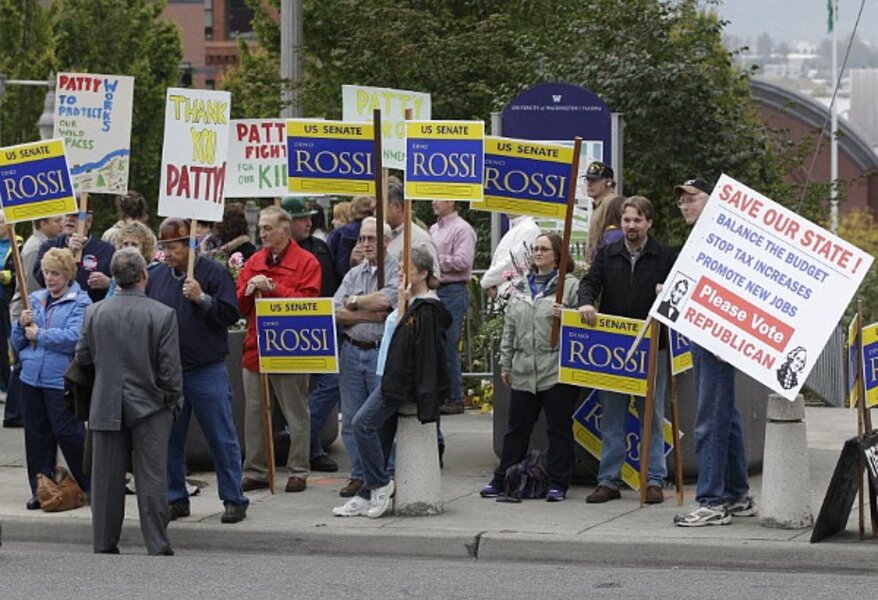How mail-in ballots might confuse polls - and Election Day results
Loading...
Election Day is more than two weeks off, and anything can happen in many key races that could determine the shape of the next Congress.
But millions of Americans already are able to vote, and many of them have marked their ballots as Election Day turns into “election month” across much of the country. More and more states are making it easier to file absentee ballots, and many states are allowing mail-in ballots to be postmarked (not just received) on Election Day.
This prolongs ballot counting, which means that in close races it could be days after voting stops before some races are decided. The practice can also throw off pre-election polls – those closely-watched indicators used to shape last-minute campaigning.
Take the US Senate race in Washington State, where three-term incumbent Democrat Patty Murray is in the fight of her life against Republican Dino Rossi.
Since 1993, voters there have been able to vote by mail, and ballots are mailed out at least 18 days before the tally begins. King County, which includes Seattle, switched to all-mail voting last year.
As polling expert Nate Silver of FiveThirtyEight.com points out, “This can wreak havoc with traditional likely voter models.” (The trend among younger voters to eschew landlines in favor of cell phones, making it harder for pollsters to find them, also throws off polling, he says.)
Voting from home increases turnout
Making it easier to vote by mail – not requiring a reason when a request for an absentee ballot is made – also has tended to increase turnout, Mr. Silver points out, and this can skew traditional polling and voting patterns. In the last midterm election in Washington State (2006), 88 percent of voters mailed in their ballots.
The situation is similar in Oregon, where all voting has been done by mail – there are no polling places – since voters approved a referendum in 1998. But this is not just a Pacific Northwest phenomenon.
Thirty-two states, plus the District of Columbia, offer some form of early voting up to two weeks before Election Day, according to the National Council of State Legislatures. This means going to an elections office. But of those 32 states, 29 allow for “no-excuse” absentee voting by mail. California, Colorado, Hawaii, Montana, Washington, and the District of Columbia allow permanent no-excuse absentee voting, which means voters may have an absentee ballot sent to them automatically for all future elections.
One indicator of the trend in early voting may be found in this year’s primary elections.
Reviewing voting patterns in key states, USA Today found that the number of early voters grew 50 percent compared to two years ago.
“Nearly 6 million people took part in early voting during this year's primary elections in the 13 states reviewed, including California, Florida and Texas,” USA Today reports. “That's up from just over 4 million voters in those same states during the 2006 primary election.”
Vote counting could go on for days
Did you enjoy the Bush-Gore presidential election in 2000, when Florida’s recount went on for days as battalions of lawyers got involved and “hanging chads” entered the political lexicon? Some neck-and-neck races could go the same way this year.
“Hundreds of lawyers from both parties [are] preparing for battles that could drag on days, weeks or even months past the Nov. 3 day-after,” reports Associated Press writer Julie Hirschfeld Davis, who suggests that a couple of Democrats – Ben Nelson? Joe Lieberman? – could switch sides in the event of a muddled outcome, giving Republicans control of the Senate.
In Washington State, meanwhile, the Murray-Rossi race is very much up in the air, with polls giving conflicting results, notes FiveThirtyEight.com’s Silver. Polling there, he writes in his New York Times column, “has been all over the map.” One shows Rossi with a 6-point edge; another has Murray (who handily won her first three US Senate races) ahead by 15 points.
Will mail-in ballots there, in a race that appears to be very close, mean a drawn-out vote tally? It’s happened before.
In his 2004 gubernatorial race against Democrat Christine Gregoire, Rossi endured months of vote challenges and two official recounts to lose by just 133 votes out of 2.8 million cast – the closest race for governor in US history.





